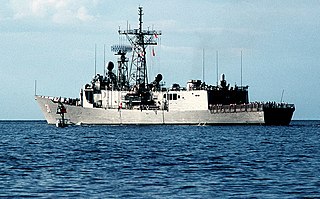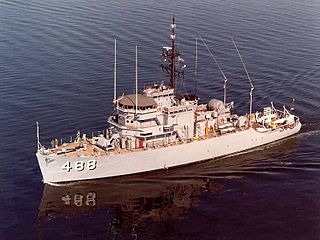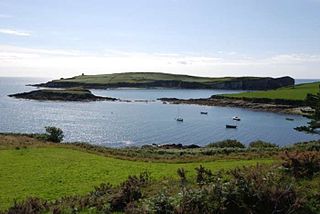
A navy, naval force, or maritime force is the branch of a nation's armed forces principally designated for naval and amphibious warfare; namely, lake-borne, riverine, littoral, or ocean-borne combat operations and related functions. It includes anything conducted by surface ships, amphibious ships, submarines, and seaborne aviation, as well as ancillary support, communications, training, and other fields. The strategic offensive role of a navy is projection of force into areas beyond a country's shores. The strategic defensive purpose of a navy is to frustrate seaborne projection-of-force by enemies. The strategic task of the navy also may incorporate nuclear deterrence by use of submarine-launched ballistic missiles. Naval operations can be broadly divided between riverine and littoral applications, open-ocean applications, and something in between, although these distinctions are more about strategic scope than tactical or operational division.

The Royal Navy (RN) is the United Kingdom's naval warfare force. Although warships were used by English and Scottish kings from the early medieval period, the first major maritime engagements were fought in the Hundred Years' War against France. The modern Royal Navy traces its origins to the early 16th century; the oldest of the UK's armed services, it is consequently known as the Senior Service.

USS Stark (FFG-31) was the 23rd ship of the Oliver Hazard Perry class of guided-missile frigates and was named after Admiral Harold Rainsford Stark (1880–1972). Ordered from Todd Pacific Shipyards in Seattle, Washington, on 23 January 1978, Stark was laid down on 24 August 1979, launched on 30 May 1980, and commissioned on 23 October 1982 with CDR Terence W. Costello commanding. In 1987, an Iraqi jet fired two missiles at Stark, killing 37 U.S. sailors on board. Decommissioned on 7 May 1999, Stark was scrapped in 2006.

The Imperial Japanese Navy was the navy of the Empire of Japan from 1868 to 1945, when it was dissolved following Japan's surrender in World War II. The Japan Maritime Self-Defense Force (JMSDF) was formed between 1952–1954 after the dissolution of the IJN.

Aurora is a Russian protected cruiser, currently preserved as a museum ship in Saint Petersburg. Aurora was one of three Pallada-class cruisers, built in Saint Petersburg for service in the Pacific. All three ships of this class served during the Russo-Japanese War. Aurora survived the Battle of Tsushima and was interned under US protection in the Philippines, and eventually returned to the Baltic Fleet.

The "largest naval battle in history" is a disputed title between adherents of varying criteria which include the numbers of personnel and/or vessels involved in the naval battle, and the total displacement of the vessels involved. While battles fought in modern times are comparatively well-documented, the figures from those in pre-Renaissance era are generally believed by contemporary chroniclers to be exaggerated.
The Roman navy comprised the naval forces of the ancient Roman state. The navy was instrumental in the Roman conquest of the Mediterranean Basin, but it never enjoyed the prestige of the Roman legions. Throughout their history, the Romans remained a primarily land-based people and relied partially on their more nautically inclined subjects, such as the Greeks and the Egyptians, to build their ships. Because of that, the navy was never completely embraced by the Roman state, and deemed somewhat "un-Roman".

The Aggressive-class minesweepers are a class of US-built minesweepers. They are designated as MSO, distinguishing them from the smaller coastal MSCs and inshore MSIs. Besides the US Navy, this class of vessels has also been used by the Belgian Navy and the Norwegian Navy, among others.

Marines, or naval infantry, are typically a military force trained to operate in littoral zones in support of naval operations. Historically, tasks undertaken by marines have included helping maintain discipline and order aboard the ship, the boarding of vessels during combat or capture of prize ships, and providing manpower for raiding ashore in support of the naval objectives. In most countries, the marines are an integral part of that state's navy.

The Ottoman Navy, also known as the Ottoman Fleet, was the naval warfare arm of the Ottoman Empire. It was established after the Ottomans first reached the sea in 1323 by capturing Karamürsel, the site of the first Ottoman naval shipyard and the nucleus of the future Navy.

USS Luzon (ARG-2) was an internal combustion engine repair ship that saw service in the United States Navy during World War II. She was the lead ship in a class of twelve and was named for the Island of Luzon, the chief island in the northern Philippines and site of the capital city of Manila. She is the second US Naval vessel to bear the name.

USS Conquest (MSO-488) was an Agile-class minesweeper in the United States Navy.

HMS Conquest was a C-class light cruiser of the Royal Navy that saw service during World War I. She was part of the Caroline group of the C class.
USS Conquest is a name used more than once by the U.S. Navy:

The Battle of Gerontas was a naval battle fought close to the island of Leros in the southeast Aegean Sea. On August 29 (O.S.), 1824, a Greek fleet of 75 ships defeated an Ottoman armada of 100 ships contributed to by Egypt, Tunisia and Tripoli.

The Harwich Force originally called Harwich Striking Force was a squadron of the Royal Navy, formed during the First World War and based in Harwich. It played a significant role in the war.

The United States Navy (USN) is the maritime service branch of the United States Armed Forces and one of the eight uniformed services of the United States. It is the largest and most powerful navy in the world, with the estimated tonnage of its active battle fleet alone exceeding the next 13 navies combined, including 11 U.S. allies or partner nations as of 2015. It has the highest combined battle fleet tonnage and the world's largest aircraft carrier fleet, with eleven in service, two new carriers under construction, and five other carriers planned. With 336,978 personnel on active duty and 101,583 in the Ready Reserve, the U.S. Navy is the third largest of the U.S. military service branches in terms of personnel. It has 290 deployable combat vessels and more than 2,623 operational aircraft as of June 2019.

The Battle of Castlehaven was a naval battle that took place on 6 December 1601 in the bay off Castlehaven on the south coast of Ireland during the Nine Years' War between a Spanish naval convoy of six ships and an English fleet, commanded by Admiral Richard Leveson and consisting of four warships. The Spanish convoy was protected by fortified positions on shore, a castle, and 600 Spanish and Irish footmen. Five out of six Spanish ships, commanded by General Pedro de Zubiaur were either sunk, captured, or run aground in the battle, while the English fleet lost no ships.

The Sack of Damietta was a successful raid on the port city of Damietta on the Nile Delta by the Byzantine navy on 22–24 May 853. The city, whose garrison was absent at the time, was sacked and plundered, yielding not only many captives but also large quantities of weapons and supplies intended for the Emirate of Crete. The Byzantine attack, which was repeated in the subsequent years, shocked the Abbasid authorities, and urgent measures were taken to refortify the coasts and strengthen the local fleet, beginning a revival of the Egyptian navy that culminated in the Tulunid and Fatimid periods.
















